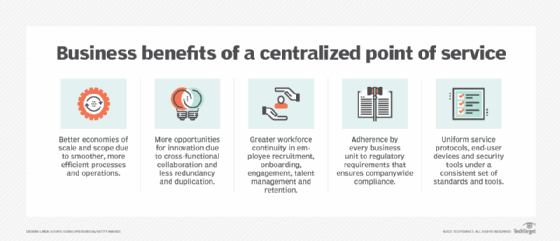shared services
What are shared services?
Shared services is a delivery model organizations use to consolidate similar business functions into a single unit that supports the entire organization. Operating as its own entity and much like a third-party vendor, the unit delivers services with each department treated as a customer. The shared services unit is sometimes called a shared services organization (SSO) or shared services center (SSC).
The shared services model is applied often to information technology (IT) services. IT services was the first SSO for many enterprises because hardware is expensive to purchase, maintain and implement with optimal training.
A balkanized approach to IT infrastructure and staffing is costly and inefficient. Centralizing IT, instead of having each department tackle it, can alleviate duplication and waste and free up funds for other strategic initiatives. Separate IT initiatives are more likely to yield siloed data stores, an increasing concern in today's world of data analytics and privacy laws, and hardware that's not utilized fully.
Combining various IT efforts in a single SSO can give the organization more efficiency and better resource utilization, reduce equipment and personnel costs, and facilitate better data governance.
Benefits of shared services organizations
Most of today's organizations now also apply the shared services model in many other areas, including finance human resources management, marketing, facilities, procurement, legal services and more. They do so because the model offers several important benefits:
- Lower costs. Shared services are more cost-effective than the siloed approach because they centralize back-office operations used by multiple departments in the same organization, eliminating redundancy and helping to achieve economies of scale.
- Strategic focus. With shared services, each department can better focus its limited resources on activities that support core initiatives and business goals, and let the SSOs handle support services.
- Operational consistency. SSOs can better refine and standardize their operations through knowledge sharing and robust feedback loops. Services can be applied more consistently with a better user experience.
- Flexibility. A single SSO can respond more quickly to changing business requirements than siloed teams. The SSO can also implement changes faster without overhauling the overall organizational structure.

How shared services organizations work
An SSO should design its service delivery model to best meet the needs of the departments it serves, treating them as valued customers, even if they are internal. When this is done optimally, the benefits accrue to employees as well as the business.

Some organizations absorb the costs of shared services as part of running the business. Other organizations use a chargeback system to bill departments that use SSO services, charging a specific cost unit under payment cycles that might be per use, quarterly or annually.
When a chargeback system is used, the SSO must be able to deliver services in a manner competitive with third-party vendors. If the services are not efficient and cost-effective, some departments might outsource the services, when possible, or try to do the work themselves.
Some SSOs define formal service-level agreements (SLAs) that outline the terms of an SSO's service delivery. This helps departments know what to expect.
The shared services concept dates to the 1920s, when an Underwood typewriter cost $100 and typists were highly trained employees. Instead of each department hiring its own typists, a group of typists known as a typing pool emerged. Today, that pool would be called an SSO or SSC.
The shared services model can be used to support multiple organizations looking to streamline operations and cut costs. For example, municipalities in a geographic region might establish an SSO that provides IT services to all those governments, eliminating the need for each one to set up its own IT department or at least substantially reducing the size and complexity of that department.
Learn about building a shared services organization structure and see how HR shared services models benefit employee experiences.








